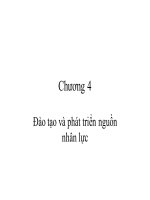BÀI GIẢNG TRANG TRÍ hệ ĐỘNG lực CHƯƠNG 2(ENGLISH)
Bạn đang xem bản rút gọn của tài liệu. Xem và tải ngay bản đầy đủ của tài liệu tại đây (12.41 MB, 47 trang )
Chapter 2
SHAFTING AND ITS COMPONENTS
IN THIS CHAPTER WE HAVE FOLLOWING UNIT:
UNIT 2.1 ARRANGEMENT OF SHAFTING
UNIT 2.2 PROPELLER SHAFT
UNIT 2.3 STERN TUBE
UNIT 2.4 STERN BEARING
UNIT 2.5 STERN TUBE SEALING
UNIT 2.6 REQUIREMENTS FOR COOLING AND LUBRICATING STERN
BEARING
UNIT 2.7 INTERMEDIATE SHAFT AND BEARING
UNIT 2.8 THRUST SHAFT AND THRUST BEARING
UNIT 2.1 ARRANGEMENT OF SHAFTING
1. Arrangement of the single shafting
1
3
5
4
2
1- E/R bulkhead
2- Stern tube
3- Water tank
4- Propeller shaft
5- Intermediate shaft
6
8
7
M/E
9
6- Intermediate bearing
7- Thrust shaft
8- Thrust bearing
9- Double bottom tank
2. Installation principle of the shafting.
There is one or more shaft line depending on kind of ships. In almost
cargo ships, the shafting has only one propeller and one shaft line is used.
Normally, a shaft line is placed parallels with the keel of the ship; in some
case the shaft line is placed unparallel with the keel. It makes with basic line
an angle α , α ≤ 5o (α - angle is formed by the shaft line and the keel of the
ship in vertical section).
In a propulsion plant with two shaft lines, they are normally installed
symmetrically and parallel to the vertical keel section of the ship. In some
cases, they make with the vertical keel section angles β (β - angle is formed
by the shaft line and the ship vertical keel section), β ≤ 3o. If α > 5o, β > 3o
then thrust force of propeller will be decreased. However, in some special
cases α is permitted till 15o.
To reduce cost and total weight of the propulsion plant; to economize
on metal and increase transmission efficiency, the shafting should be
shortened.
α
β
β
β
β
3. Position of shaft bearings.
Shaft bearings are usually positioned near bulkhead or keel of the
ship where ship's hull structure is strongest. Position of the shaft bearings
relates to vibration of the shafting.
According to the rule of Russia Register:
12D < L < 22D
Where:
D - Diameter of a shaft
L - Distance between shaft bearings.
If D < 100 mm, L is calculated:
Lmax = 91 3 D 2
UNIT 2.2 PROPELLER SHAFT (TAIL SHAFT)
Key
Taper
Shaft
Figure 2.2: Structure of the
propeller shaft and the
propeller boss
UNIT 2.3 STERN TUBE
There are many differences in structure of stern tube depending on individual ship and
kinds of stern bearing. Its function is to place bearing for supporting of propeller and
propeller shaft. With heavy load, so its structure must be strong enough to withstand the
acting forces. At the aft end of stern tube is provided with lock nut to secure stern tube to
stern frame. The fore end of stern tube is secured to bulkhead by bolts and nuts.
11
7
1- Propeller shaft
6
2- Stern tube
5
12
2
9
3- Metal bush
4, 5- Stern bearing
6- Stern frame
7- Stern tube nut
8- Retaining ring
8
9- Gland cover
4
3
1
Figure 2.3: Stern tube
10- Packing
10
11- Aft peak bulkhead
12- Water pipe
UNIT 2.4 STERN BEARINGS
The propeller shaft is supported by stern bearings. There is one or
more bearing for each of the propeller shaft depending on the structure of the
ship and length of the propeller shaft. Stern bearings withstand too heavy
working conditions; it is very difficult to inspect and repair (unless on dry
dock). So its structure must be strong enough to ensure safe operation of the
ship.
There are some kinds of materials for making stern bearings such
as:
- Special wood (lignum vitae).
- Synthetic r ubber.
- W hite metal.
Special wood and synthetic rubber bearings are lubricated and cooled
by water while lubricating oil (L.O) is used for white metal bearings.
1. Special wood bearing (lignum vitae bearing).
a. Structure.
The traditional propeller shaft or stern bearing is lubricated by water. It
consists of a number of lignum vitae staves located in longitudinal grooves in a
metal bush. Lignum vita is a kind of hard wood with very good wear characteristics
and it is compatible with water.
The staves with against the grain are used in lower part of the bearing.
They have a higher longevity than staves with the grain. These staves are closely
placed and secured by brass plate. The length of secured plate is equal to length of
the staves and thickness of this plate is about 60% of the staves. Two or three brass
plates can be used to secure the staves. When the bearing is working with watercooling, the staves will expand boundary and create pressing force to each other.
The metal bushes in which the staves are mounted are pressed into cast
iron stern tube. At the after end of the metal bush is provided with a shoulder and it
is secured by a lock nut on the stern tube. Generally, two staves bush are fitted in
the stern tube. The aftermost bush has a length about 4 times the diameter of the
shaft and it is the main bearing unit. The forward bush is short and acts mainly as a
guide. The center (unbushed part) of the stern tube is connected to a seawater
service line, which, together with ingress of water between the shaft and aft bush,
provides lubrication.
To increase longevity of the propeller shaft, the brass sleeves must be fitted.
Clearance of fitting: D1 = 1.003D + 1.0
(mm)
Where D1 is inside diameter of the bearing, D is outside diameter of the shaft
(including brass sleeve).
4
3
1- Propeller shaft
6 2- Brass sleeve
3-Lignum vitae
4- Metal bush
5- Screw
2
6- Secured plate
5
1
Figure: Lignum vitae bearing
b. Advantages of lignum vitae bearing.
- This kind of bearing is very suitable for propeller shaft, which has a big
diameter and low speed.
- It is safe in operation.
- Absorb vibration of the propeller shaft.
- Maintain clearance between shaft and bearing if optimum cooling and
lubricating.
- Longevity is high (about 10 years)
c. Disadvantages
- Lignum vitae are an uncommon material. It is very expensive.
- It is difficult in manufacturing.
- Bearing is excessively worn if the ship is sailing in shallow and dirty
water, especially when sand comes into clearance of the bearing.
2. Synthetic rubber bearing (Rein forced rubber).
a. Structure.
There are some differences in structure of synthetic rubber bearings but basically, the
rubber staves are positioned in a metal bush. A groove is made between two staves to let
water flow in for lubricating. The metal bush is fixed to the stern tube by screws (metal
bush must not rotate). The same with special wood, brass sleeves must be inserted to
propeller shaft in case of rubber bearing. The friction coefficient between rubber bearing
and brass sleeves in water is about 0.02 ÷ 0.007 depends on kinds and shapes of rubber
bearing.
2
1
1- Stern tube
Soft rubber
3- Rein forced
rubber stave
Hard rubber
5
2- Metal bush
4- Brass sleeve
5- Propeller shaft
4
3
Figure 2.5: Synthetic rubber bearing
3. White metal bearing.
a. Structure.
5
Figure: White metal bearing
4
3
1- Propeller shaft
2- Stern tube
3- White metal
4- White metal liners
5- Oil groove
1
2
A typical analysis of white metal is 3% copper, 7.5% antimony the remain is tin. The
thickness depends on requirement of registry. Lloyd’s register recommends the thickness
of 3.8 mm for shaft 300 diameters, up to 7.4 mm for shaft 900 diameters. The bearing
clearance can be calculated: D1 = 1.001D + 0.5 (mm)
Where: D1 - Inside diameter of the bearing, D - Outside diameter of the shaft.
White metal liner must be fixed to the stern tube otherwise it will be turned together with
shaft and be soon damaged. The white metal bearing must be lubricated by lubricating oil.
5
11
7
8
6
5
4
12
2
3
1
9
10
UNIT 2.5: STERN TUBE SEALING
FUNCTION:
• Its function is to prevent leakage of seawater through, or loss
of oil from, the stern bearings.
• Shaft seals are very important during operation of the shafting;
they maintain good condition of the stern bearings and
protecting marine pollution.
• Nowadays, there are two common types of shaft seal are used
widely on board ships. They are:
* Gland packing
* Simplex shaft seal types:
- Aft seal
- Forward seal
1. Gland packing seal type.
structure:
• It consists of simple stuffing boxes filled with packing material; usually rove cotton imbrued
with tallow or graphite as a lubricant. In the case of high duty packing the material may be
white metal clad.
• These packing are tight to the shaft that make the sealing function
• Gland packing can be lubricated by water or lubricating oil.
• Gland packing are adjusted by tightening or loosening gland cover (4).
3
2
4
1- Propeller shaft
2- Stern tube
3- Gland packing
4- Gland cover
5- Metal bush
1
5
Figure: Structure of gland packing seal
• Advantages:
- Simple and cheap.
•
Disadvantages:
- Water always penetrates to the engine room.
- Longevity of the packing is low.
- Force of loosing and tightening must be suitable.
- Gland packing have to assembly onboard the ship…
• Application:
- This kind of shaft seal is only used onboard the small and
the former ship.









